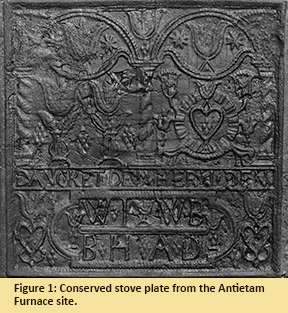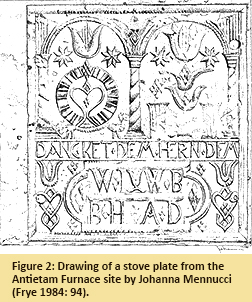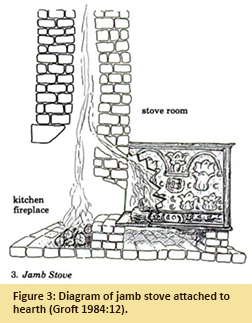Curator's Choice 2016
Scripture in Iron: Pennsylvania German Stove Plates from Antietam Furnace
April 2016
By Rebecca Morehouse, MAC Lab State Curator
 In the early 1980s, archaeological investigations uncovered the remains of Antietam Furnace, a well-preserved 18th century frontier blast furnace, in Washington County. Constructed in 1761, this furnace produced a variety of cast iron objects, as well as "pig iron", which would have been further refined to make wrought iron. The blast furnace was in operation up until the American Revolution, when the owners received large contracts to cast cannon from the State of
In the early 1980s, archaeological investigations uncovered the remains of Antietam Furnace, a well-preserved 18th century frontier blast furnace, in Washington County. Constructed in 1761, this furnace produced a variety of cast iron objects, as well as "pig iron", which would have been further refined to make wrought iron. The blast furnace was in operation up until the American Revolution, when the owners received large contracts to cast cannon from the State of  Maryland and the Continental Congress. Since Antietam Furnace was too small for this purpose, it was abandoned and the larger Mt. Aetna Furnace was constructed nearby in the mid-1770s (Frye 1984: 159).
Maryland and the Continental Congress. Since Antietam Furnace was too small for this purpose, it was abandoned and the larger Mt. Aetna Furnace was constructed nearby in the mid-1770s (Frye 1984: 159).
Some of the most interesting objects cast at the furnace were elaborately decorated cast iron stove plates for a five-plate, or jamb, stove (Figures 1 and 2). These stoves were used almost exclusively by the German immigrants in Pennsylvania and the Great Appalachian Valley of Maryland and Virginia (Frye 1984: 90). Used for radiant heat in northern European homes since the mid-1500s, many of the first German immigrants brought this style stove with them when they emigrated from Germany (Conococheague Institute Blog 2013).
Tammis Groft describes how a jamb stove would be installed up against a home's central chimney:
The five plates formed an open box that was placed against an aperture in the wall that opened into the kitchen fireplace of the next room. Live coals were inserted into the stove through the opening in the fireplace. The adjacent room, thus, was heated economically without the discomfort of smoke (1984: 12) (Figure 3).
 Prior to 1750, jamb stove plates displayed biblically- themed scenes along with quotes from scripture. By the time stove plates were being cast at Antietam Furnace in the 1760s, the pictorial scenes had been replaced by a stylized floral motif, but the scriptural quotations remained (Frye 1984: 92).
Prior to 1750, jamb stove plates displayed biblically- themed scenes along with quotes from scripture. By the time stove plates were being cast at Antietam Furnace in the 1760s, the pictorial scenes had been replaced by a stylized floral motif, but the scriptural quotations remained (Frye 1984: 92).
The eight complete stove plates recovered from Antietam Furnace all had this floral motif, which included a combination of lozenges, hearts, and tulips. This design became ubiquitous on jamb stove plates after the mid-1750s. Having no known religious significance, it is unclear why the more interesting pictorial scenes were abandoned for it (Mercer 1961: 70-72). A German inscription in the center of the plate read "DANCKET DEM HERN DEM", which translates "Give thanks unto the Lord". The verse was completed on the front plate: "ERIST FREUNDLICH", with translates "He is good." Only a few fragments of the front plate survived at the Antietam Furnace site (Frye 1984: 95). A complete example is illustrated in Mercer (1961: Plate 141) (Figure 4). The initials  "WJ", "WB", and "BH" stand for the furnace owners William James, William Buchanan, and Barnabas Hughes (Figures 1 and 3). The initials "AD" are those of an unknown individual, but one who likely had an important role in the furnace's operation (Frye: 1984: 95).
"WJ", "WB", and "BH" stand for the furnace owners William James, William Buchanan, and Barnabas Hughes (Figures 1 and 3). The initials "AD" are those of an unknown individual, but one who likely had an important role in the furnace's operation (Frye: 1984: 95).
At the time these stove plates were being cast at Antietam Furnace, the jamb stove was a dying technology and was being replaced, even in some German homes, by the Dutch six-plated stove (Harris 2013: 3). These "Holland" stoves had a closed firebox which contained its own wood fire, eliminating the need to shovel live coals into it from the fireplace. This free-standing and portable stove, with its own flue at the rear of the top plate, didn't require the Pennsylvania German central chimney. This allowed it to be installed in rooms with chimneys on a home's outer walls or gable ends (Harris 2013).
By the end of the 18th century, large flat plate stoves were no longer being made and many existing stoves had been disassembled and their individual stove plates used for other purposes (Conococheague Institute Blog 2013). During his early 20th century study of stove plates, Henry Mercer found stove plates being used as cistern covers, chimney caps, stepping stones, and firebacks (1961: 3). The 19th century six-plate stoves were a similar design to their 18th century predecessors; however, advancements in technology made them lighter and more finely cast (Antique Stoves 2000). Versions of these kinds of stoves are still used to heat homes throughout the United States today.
| References |
|
| Antique Stoves |
| 2000 |
A Brief History of Cast Iron Stoves in America. Web resource: http://www.antiquestoves.com/history.htm accessed March 30, 2016. |
|
| Conococheague Institute Blog |
| 2013 |
Visit Our Newest Exhibit: The Stove Plates of Rock Hill Farm. Web resource: http://cimlg.org/ciblog/tag/german-jamb-stove/ accessed March 9, 2016. |
|
| Frye, Susan Winter |
| 1984 |
Archeological Excavations at the Antietam Iron Furnace Complex (18WA288) Washington County, Maryland. Maryland Historical Trust Manuscript Series No. 37. |
|
| Groft, Tammis |
| 1984 |
Cast with Style: Nineteenth Century Cast-Iron Stoves from the Albany Area. Albany, New York. Albany Institute of History and Art. |
|
| Harris, Howell |
| 2013 |
A Stove Less Ordinary Blog:A Collection of Stoves from American Museums, I: Plate Stoves. Web resource: http://stovehistory.blogspot.com/2013/10/a-collection-of-stoves-metropolitan.html accessed March 9, 2016. |
|
| Mercer, Henry C. |
| 1961 |
The Bible in Iron. Doylestown, Pennsylvania: Bucks County Historical Society. |
|